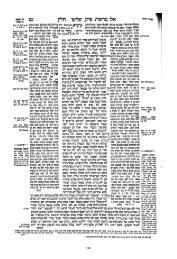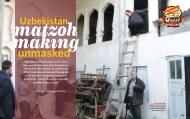The Jews of Eritrea - Halachic Adventures
The Jews of Eritrea - Halachic Adventures
The Jews of Eritrea - Halachic Adventures
- No tags were found...
Create successful ePaper yourself
Turn your PDF publications into a flip-book with our unique Google optimized e-Paper software.
<strong>The</strong> British may have succeeded in isolating the prisoners from their Israelicomrades, but they didn’t take into account the local Jewish support. <strong>The</strong> <strong>Jews</strong> <strong>of</strong>Asmara, Addis Ababa, and Djibouti helped the escapees by providing food and shelter<strong>The</strong> doorpost is a witness to once-thriving Jewish lifeAfter years <strong>of</strong> disuse, the mikveh still functions<strong>The</strong> synagogue compound. “We had schoolsand social programs,” Sami remembersMatzoh oven in the Cohen courtyard: Today it all comes from Israel46 13 Teves 5770 12.30.09building with a typical Sephardic sanctuary and a small balcony forthe women’s gallery. <strong>The</strong> aron kodesh still holds two sifrei Torahin their traditional Sephardic wooden cases, which are occasionallyused. For example, a minyan happened to be present on ShabbosZachor two years ago, and read from both Torahs. In many NorthAfrican shuls, tzedakah boxes are built into the side <strong>of</strong> the bimah,designated for various communal needs. Asmara is no exception,and the various slots are still labeled: the poor <strong>of</strong> Asmara, the poor <strong>of</strong>Jerusalem, Rabbi Meir Baal HaNes, and, so as not to forget the folksback in the alter heim, “the poor <strong>of</strong> Aden.”<strong>The</strong> mikveh in the shul compound still has water in it, althoughit is not very clean and it has probably not been used in years. Thismikveh has two side-by-side pits, an otzar for the rainwater and animmersion basin where the person toivels.<strong>The</strong> local Jewish school, where all community members senttheir children, had several rooms in the shul compound — sharingspace with chickens that would be slaughtered in the compound.Larger animals were handled in a slaughterhouse around the corner.A large house that was built by the prominent Banin-Mansourfamily and owned by Shoa Menachem Joseph, president <strong>of</strong> thecommunity from 1916 until his death in 1965, is currently thePension Milano hotel. Sami advised us to visit the building andsee the many obvious indications <strong>of</strong> its history as a former Jewishresidence; artistically designed plaster Magen Davids in theceilings, and stained-glass Magen Davids on the windows. Fromour perspective, the most significant testimony <strong>of</strong> a Jewish presencewas the doorways, where the mezuzah marks and nail-holes are stillclearly evident. We could not help but wonder: What happy eventshad occurred within these walls? What songs had echoed in thehallways when the zemiros were sung and the Torah learned? Whatcommunity meetings were held in this house, and what decisionswere made that affected the lives <strong>of</strong> its members?We have done much research in the history <strong>of</strong> matzohpreparation in communities around the world, so we werecurious about <strong>Eritrea</strong> as well. As with most small communitiestoday, for the last several decades all matzos have been imported.Sami Cohen, however, still has a matzoh oven in his backyard.“I remember when my mother would bake matzos here, butsince the 1950s we have imported them from Israel. In recentyears it’s been used for baking challah.”Prison for <strong>Jews</strong> It’s always fascinating, but never reallysurprising, to find an Israeli connection even in the remotestplaces, and Asmara is no exception. After the British pushedout the Italians in 1941, they found Asmara useful in anotherway. At the height <strong>of</strong> anti-British Irgun activity in Palestine, theBritish were becoming increasingly frustrated in their attemptsto guard difficult prisoners on Israeli soil. <strong>The</strong> British decidedto utilize Asmara as a penal colony, following the models <strong>of</strong> thenineteenth-century British prisons in the Australian wilds, andFrance’s notorious Devil’s Island in French Guiana.In the dead <strong>of</strong> night in October 1944, in a swift, surprisemove known as Operation Snowball, 251 <strong>of</strong> the toughest Irgunand Lechi fighters were taken from Latrun Prison and whiskedaway by plane to Asmara. In those days, with limited air travel,the town was truly isolated, much like today’s American campin Guantanamo Bay, Cuba. <strong>The</strong> “Jewish terrorists,” <strong>of</strong> whomthe British were terrified, were taken without notice and sent todesolate Africa to be held without a trial or time limit in SambalPrison in <strong>Eritrea</strong>; to Carthage, Sudan; and to Gilgil, Kenya.Later other prisoners were added to the original group, bringingthe total to over 400.During the twenty months that the <strong>Eritrea</strong>n camp was inexistence, a dozen prison breaks occurred. Among thoseshipped to Sambal Prison in <strong>Eritrea</strong> was former Prime MinisterYitzchak Shamir, the commander <strong>of</strong> the Lechi. Shamir leftbehind his wife and one-year-old son, whom he didn’t see againuntil 1948, following a dangerous and successful escape. <strong>The</strong>powerful and compelling story <strong>of</strong> these men is recounted in thebook, Long is the Road to Freedom, by another former prisoner,Yaakov Meridor, Menachem Begin’s number-two man.<strong>The</strong> British may have succeeded in isolating the prisonersfrom their Israeli comrades, but they didn’t take into accountthe local Jewish support. <strong>The</strong> <strong>Jews</strong> <strong>of</strong> Asmara, Addis Ababa,and Djibouti helped the escapees by providing food and shelter.<strong>The</strong> building in which they were incarcerated is still used as ajail, and thus we were only able to see it from a distance. In the1950s, when the State <strong>of</strong> Israel was trying to cope with waves<strong>of</strong> immigrants and food was scarce, Yaacov Meridor openeda kosher meat-canning factory in Asmara, and shochtim fromIsrael worked there, providing meat for the young country andits army.Cemeteries Tell the Story Adjacent to what must beone <strong>of</strong> the smallest public zoos in the world, containing nothingmore than a few birds, guinea pigs, and — the big attraction— hyenas, we saw the well-manicured British cemetery fromWorld War II. <strong>The</strong> cemetery contains seven Jewish graves,soldiers who fought with the British against the Italians.As in all Jewish communities, the <strong>Eritrea</strong>n Jewish cemeterytells its own story. This cemetery is a separate section <strong>of</strong>the larger Asmara Christian Cemetery; it was given to thecommunity when it started over a century ago. In 1951 themunicipality wanted to relocate the graves and use the landfor immoral purposes. Wealthy community president ShoaMenachem Joseph purchased the land on behalf <strong>of</strong> the <strong>Jews</strong> andto this day it remains in Jewish hands. <strong>The</strong> non-Jewish caretaker<strong>of</strong> the entire cemetery also looks after the Jewish section.On January 17, 1946, Sudanese guards in Sambal Prisonkilled two Israeli prisoners, who had broken down a gate in


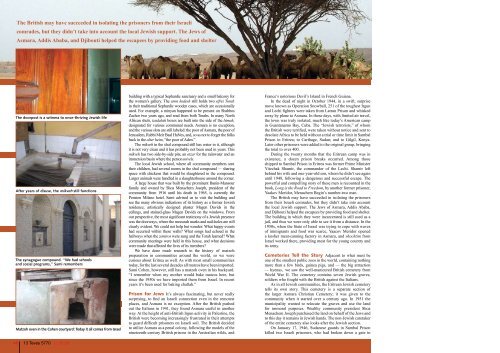

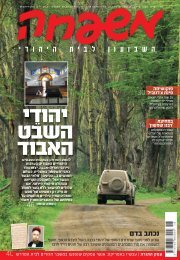


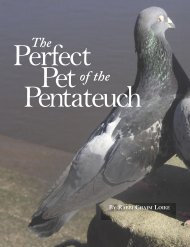
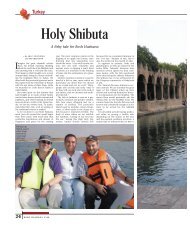
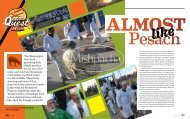

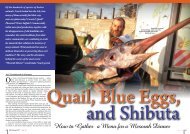
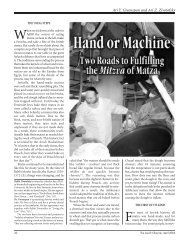
![llVtlwnl 1p1l 1biip 3 K11lnM o1it1 [1] - Halachic Adventures](https://img.yumpu.com/35271577/1/190x253/llvtlwnl-1p1l-1biip-3-k11lnm-o1it1-1-halachic-adventures.jpg?quality=85)

